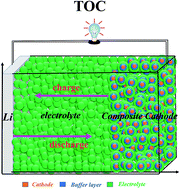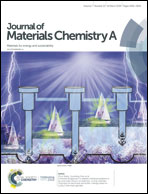A theoretical approach to address interfacial problems in all-solid-state lithium ion batteries: tuning materials chemistry for electrolyte and buffer coatings based on Li6PA5Cl hali-chalcogenides†
Abstract
Even though ultra-fast Li+ ion conductors based on sulfides such as LGPS and Li6PS5Cl have been developed in recent years, rather limited advancement has been made towards developing all-solid-state lithium ion batteries due to serious interface-related problems. Here in this work, we have carried out extensive fundamental modelling to formulate a system of materials based on hali-chalcogenide Li6PA5Cl argyrodites (A is the site for chalcogen species), so that materials with chemically and structurally compatible characteristics can be used as both a superb electrolyte and excellent buffer coatings over electrode surfaces. All solid-state-batteries (ASSBs) in the form of Li|Li6PO4SCl|Li6PO5Cl|Li0.25MnO2 are thus recommended, so that buffer coatings based on O-rich hali-chalcogenides help avoid interfacial reactions, owing to their high stability with respect to the cathodes and greatly enhanced chemical potential with respect to Li/Li+. Such batteries fundamentally have high mechanical and electrochemical stability, thus enabling high performance and great endurance to operational voltage.



 Please wait while we load your content...
Please wait while we load your content...